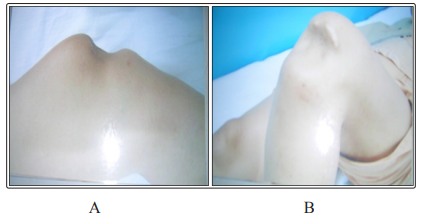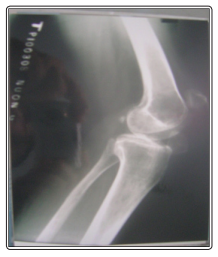Author(s): Le Phuc
Pseudarthrosis of Patella is a rare complication, especially when the two fragments are in the state of great separation. A gap between the two fragments creates a shape of Double-hump Camel which enables physician to access the clinical diagnosis.
Patient’s knee is observed from lateral side. Two patellar fragments are in severe separation displacement, a gap exists between two fragments. Bigger the gap is clearer Double-hump Camel Sign shows. Figure 1. Patient still can walk with unbalanced gait but cannot run, jump as normal as preinjury. Quadriceps muscle forces of the involved limb decrease, especially knee extension is clearly weak. Mere clinical manifestation of Double-hump Sign is sufficient to diagnose pseudarthrosis of patella. X-rays, however, is necessary to confirm diagnosis and show characteristics of patellar pseudarthrosis and nearby structures.

Figure 1: Patient’s knee is observed from lateral view [A] and semi AP view [B]. The gap between two patellar fragments which are in great separation displacement constitutes an image of Doublehump Camel

Figure 2: X-rays however necessary to confirm diagnosis and show detailed characteristics of pseudarthrosis and nearby structures
Clinical examination is very important to diagnose a lesion of skeletal apparatus [1-4]. The patella is not exceptional, needs clinical manifestations and radiographic imaging for diagnosis [1-2]. Specially, in pathology of patellar pseudarthrosis, when displacement is in great separation, a gap between two fragments exists, bigger during knee flexion, creates an image of Doublehump Camel which enables the physician to diagnose with exactness. The sign is pathognomonic for patella pseudarthrosis. Of course, in any cases, a radiographic finding is always necessary to show more detailed involvements.
Double-hump Camel Sign is helpful for the diagnosis of patella pseudarthrosis. It is a relevant clinical finding which examiner should look for in all patellar fractures especially the old ones. The sign should be recognized as a contribution to the medical literature of orthopedic semiology
